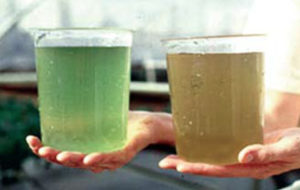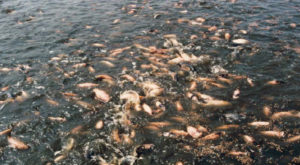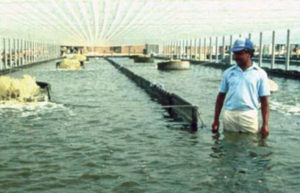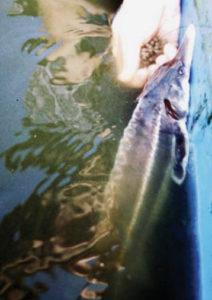Natural treatment method supports fresh-water, marine species in recirculating systems

In recent years, the suspended microbial floc process has gained attention and worldwide use, primarily for farming marine shrimp in intensive, closed-cycle ponds. But few people are aware of its history and potential for culture of a variety of fresh-water and marine fish. The author has used microbial floc treatments over 30 years for water treatment, natural food production, nutrient recycling, and disease prevention for varied species in recirculating tanks and raceway systems.
ODAS, microbial floc processes
Many names have been used for suspended microbial floc treatments. ODAS, short for organic detrital algae soup, was used in projects developed by the author, but “microbial floc” appears to be the term upon which most users have agreed.
Microbial flocs consist of a wide variety of beneficial nitrifying bacteria, fungi, protozoans, ciliates, rotifers, brown and green microalgae, grazing microinvertebrates and detritus. They are continuously mixed and suspended, treating and bioconverting via autotrophic, heterotrophic, and filter-feeding/grazing microorganisms both dissolved and particulate wastes into microbial biomass.
These flocs are essentially the same as the suspended flocs, detritus, and planktonic organisms in nutrient-rich marine estuaries, which are among the world’s most productive ecosystems and nursery habitats for a wide variety of marine fish, shellfish, and shrimp.
Advantages of microbial flocs

The microbial floc treatment method is not for everyone. It requires completely different thinking than conventional biofilter systems. Instead of trying to clarify and sterilize water by removing and disposing of as much particulate waste as possible, microbial flocs bioconvert both dissolved and particulate wastes for use in several beneficial ways.
The particulate wastes create a suspended detrital substrate for microorganisms, eliminating the need for expensive artificial biosubstrates and associated support equipment. The microbial floc bioconverts most wastes into natural food organisms for filter-feeding species like tilapia and marine shrimp, reducing feed and waste disposal costs.
Microbial flocs function directly within fish tanks, reducing the size and cost of piping, pumps, and controls for a separate biofilter system, and allowing closed-cycle operation of individual tanks when desired. Probiotic bacteria in the microbial floc continuously surround the fish or shrimp and provide natural disease prevention and control.
Floc projects
Marine shrimp in intensive tanks

A suspended microbial treatment process developed by the author was originally tested for intensive culture of Penaeus vannamei shrimp in closed-cycle, aerated, greenhouse-covered tank systems in Encinitas, California, USA, in 1978. The method eliminated expensive water filtration components and bioconverted wastes into natural food for the shrimp, reducing feed costs.
Chopped straw in baskets was used as an organic carbon source for heterotrophs and to stimulate the food chain. Although the method proved successful, it was too difficult to raise funds for scale-up because the system was too radical a concept at the time.
Tilapia in treated distillery effluent
In 1980, the ODAS process was used to treat and bioconvert alcohol distillery effluents into microbial protein for tilapia. A wide variety of microbial floc organisms, including microalgae, was adapted for the extremely high strength and toxicity of the effluent, which was about 100 times stronger than raw sewage.
With a 1:1 dilution with fresh water and the addition of bacteria from a polluted local lagoon that thrived on the distillery waste, the effluent was finally made safe for the tilapia, which thrived in the treated effluent and microbial floc. Twenty hectares of bioconversion and grow-out raceways were eventually constructed.
Production from the aerated raceways averaged about 22 metric tons (MT) per hectare per year, for a total of about 450 MT per year of tilapia. Supplemental feed was provided, since the natural foods were insufficient to support that density of fish production. Final effluent was used for rice farming.
Solar Aqua Farms tilapia
During the 1980s, the author developed a large commercial-scale tilapia farm in southern California, USA, for the production of high-quality fillets. A closed-cycle treatment process was required due to the shortage of fresh water, environmental restrictions, and need to prevent tilapia escape. Microbial flocs were used to reduce water treatment capital and operating costs, feed costs, and final waste disposal.
There were 7.3 ha of circular 29.3-meter-diameter tanks and 18.3 x 146.3-m raceways covered by greenhouses for hatchery and grow-out. Yield rates averaged 65 to 70 kilograms per cubic meter annually. The total farm production capacity was 2,270 MT per year.
Extensive research was done to develop low-cost, low-protein diets, and to increase the nutritional value of the detrital soup to the tilapia. The ODAS process was remarkably stable over many years, maintaining ammonia and nitrite levels under 0.6 ppm. The lower-protein feeds improved carbon:nitrogen ratios for more heterotrophic uptake of ammonia. Because no extra carbon was added to fish tanks, both autotrophic and heterotrophic bacteria were active, so nitrate accumulated.
Denitrification was accomplished as a side stream in separate “biofilter” tanks with the same ODAS organisms through the addition of organic carbon (molasses or corn syrup) and lowering oxygen levels to under 1.0 ppm. Instead of the 10 to 30 percent water exchange rates common in most intensive recirculating culture systems, the daily water input rate at Solar AquaFarms was only 0.5 percent of system volume, which was supplied from an on-site well. There was no off-site discharge, and final excess solids were digested in a settling lagoon/marsh for eventual land application.
A similar tilapia farm was developed during the 1990s in Jordan using technology provided by Solar AquaFarms. The farm is still operating profitably, selling whole tilapia to local markets.
Marine fish culture

From 1996 to 2001, the author directed the aquaculture project at Mote Marine Laboratory in Florida, USA, to culture snook for stock enhancement, as well as pompano, permit, and several snapper species in low-salinity recirculating tank systems. Even though these species can not utilize microbial protein directly, there were other reasons for using a microbial floc process.
For snook stock enhancement, it was essential to produce juveniles using entirely natural methods that would expose the fish to the full range of natural bacteria and organisms in the wild. A diverse microbial community was created using local organisms supplemented with cultures of probiotic bacteria for larval, fry, and fingerling culture. The probiotic floc worked very well, for no disease problems occurred over a five-year period.
The microbial floc process also worked well for water treatment and disease prevention with the other marine fish species. For parasite control, salinities below 10 ppt and hydrogen peroxide dips were sufficient. Tilapia were raised in “biofilter” tanks downstream of the marine fish to harvest the microbial floc and uneaten feed.
The two drawbacks for the microbial floc process for marine fish were related to staff and visitors, not the fish. People naturally prefer clear-water systems to see the fish, and in research projects with a variety of species and frequent visitors, the low visibility with microbial floc process may not be appropriate.
A second problem was the frequent tendency of new technicians, interns, and volunteers to drain the “dirty” water and refill tanks with “clean” water, not realizing they had thrown away the biofilter. To avoid disrupting experiments with the resultant ammonia spikes, conventional biofilters were added to each system to back up the microbial floc, which simply passed continuously through the biofilters.
Sturgeon culture
At Mote Marine Laboratory during the same period described above, six species of sturgeon were hatched and raised to determine the feasibility of sturgeon culture in recirculating systems in Florida. Most were Caspian Sea/Russian species.
The flocs and brackish water simulated the natural Caspian Sea and Volga/Danube River environments, and provided probiotic disease control and the lower light preferred by the sturgeons. In addition, the sturgeons appeared to consume the settled floc.
A second sturgeon project using microbial flocs was developed by the author for a commercial farm in eastern Canada that raised shortnose sturgeon in recirculating greenhouse tank systems. Even though conventional biofilters were installed to share the nitrification load, the colder water greatly reduced nitrification rates. The microbial floc heterotrophs proved highly beneficial, because the addition of organic carbon to the culture water as needed rapidly dropped ammonia and nitrite levels, often within only a few hours.
Design, management
Although the above projects using microbial flocs represent a wide variety of species, salinities, and climates, many common issues and management techniques have emerged.
Autotrophs Vs. Heterotrophs
There is a broad misunderstanding in the biofilter community about autotrophs versus heterotrophs. Endless publications state that heterotrophs are “bad” and particulate/organic wastes must be removed in order to eliminate heterotrophs and allow biofilters to function properly. In fact, few scientists can truly identify autotrophs and heterotrophs, and when they do, many bacteria show the capacity to switch back and forth depending on the availability of organic carbon.
All biofilters and floc systems have both heterotrophs and autotrophs. The issue is, do you want to pass the ammonia through the autotrophic pathway, ending up with nitrate accumulation, or pass it through the heterotrophic pathway and end up with microbial protein (nitrogen immobilized within microbial biomass). This is easily done by adding, or not adding, organic carbon on a steady hourly or daily basis. Big advantages of heterotrophs are their extremely rapid growth and ammonia uptake compared to autotrophs, solving ammonia problems in hours instead of weeks.
Carbon Issues, Lower-Protein Feeds
Critics of the heterotrophic microbial floc method say the need for daily organic carbon addition or low-protein feeds with high carbon:nitrogen ratios is an extra expense and task. But in recirculating systems with low or zero discharge, an autotrophic nitrification process quickly produces toxic levels of nitrate, and denitrification by adding carbon to an anaerobic stage is the most common solution.
The carbon required for either process is about the same, so the real issue is do you want to produce and/or harvest a microbial biomass, or operate an anaerobic denitrification system with the carbon? If the species raised can utilize the microbial floc, or a second, filter-feeding species is added downstream, then going the microbial floc route makes economic sense. Otherwise, it’s probably an even trade-off.
Flavor: Nonissue
Another major misunderstanding about microbial floc systems is the assumption that water with high suspended solids and/or algae causes off-flavor. Not so. The author has used microbial floc systems for over 20 years with a variety of species and salinities, including commercial “finishing” systems managed specifically for flavor optimization, with ODAS the sole treatment method.
Designers and owners of “clear-water” recirculation system are often shocked to discover their fish are badly off flavor. The causes of off-flavor are beyond the scope of this brief article, but are related to the anaerobic breakdown of organic matter, not aerobic, suspended microbial floc or algae. A few rare species of blue-green algae can add off-flavor in stagnant pond systems, but they do not survive in suspended microbial floc systems.
(Editor’s Note: This article was originally published in the June 2006 print edition of the Global Aquaculture Advocate.)
Now that you've finished reading the article ...
… we hope you’ll consider supporting our mission to document the evolution of the global aquaculture industry and share our vast network of contributors’ expansive knowledge every week.
By becoming a Global Seafood Alliance member, you’re ensuring that all of the pre-competitive work we do through member benefits, resources and events can continue. Individual membership costs just $50 a year. GSA individual and corporate members receive complimentary access to a series of GOAL virtual events beginning in April. Join now.
Not a GSA member? Join us.
Author
-
Steven A. Serfling
Sunwater Technologies
7350 S. Tamiami Trail
Sarasota, Florida 34231 USA
Tagged With
Related Posts

Health & Welfare
Ammonia addition enhances microbial flocs in nursery phase for Pacific white shrimp
In a study, “pre-fertilization” in the nursery phase of a biofloc system for shrimp was tested. The objective was to accelerate the biofloc formation to minimize ammonia concentrations, avoiding high peaks during culture.

Health & Welfare
A holistic management approach to EMS
Early Mortality Syndrome has devastated farmed shrimp in Asia and Latin America. With better understanding of the pathogen and the development and improvement of novel strategies, shrimp farmers are now able to better manage the disease.

Aquafeeds
Biofloc consumption by Pacific white shrimp postlarvae
The stable isotopes technique with δ13C and δ15N can be used to determine the relevance of different food sources to shrimp feeding during the pre-nursery phase of Litopenaeus vannamei culture. During this trial, different types of commercial feed, microalgae, Artemia sp. nauplii and bioflocs were used as food sources.

Aquafeeds
Biofloc systems viable for tilapia production
Well-designed and managed biofloc technology systems are a viable alternative for production of various species like tilapia, to increase feed efficiency by lowering aquafeed protein requirements and to help reduce or eliminate effluent discharges.


